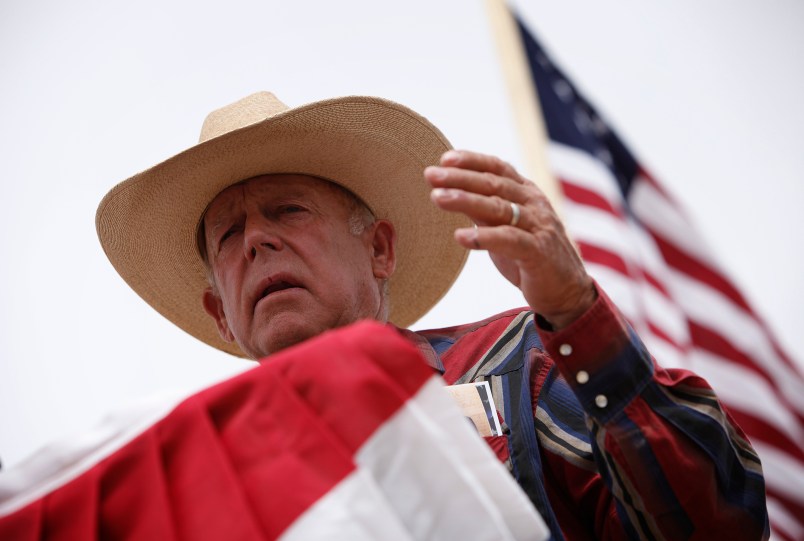The 2014 showdown at Cliven Bundy’s ranch in Nevada has found its 2016 sequel, with two of his sons among the anti-government extremists taking over a federal wildlife center in Oregon to protest the government’s public land policies.
The situation presents a complicated challenge for authorities seeking to end the standoff peacefully but armed militia members itching for a confrontation. But some observers caution that once it is settled — however it is ultimately resolved — those involved must face consequences, unlike Bundy himself, who was never sanctioned for his armed showdown with the government and still owes some $1 million in disputed public grazing fees that triggered the initial incident.
“These folks are militant extremists and they need to be treated as such,” Jessica Goad — advocacy director at the Center for Western Priorities, a conservation group which has monitored the rise of anti-government groups — told TPM. “They need to be brought to justice in order for this thing not to keep occurring in the future.”
Back in 2014, the armed anti-government forces were facing down officials over the Bureau of Land Managements plans to remove Bundy’s cattle from federal lands after years of court battles over public grazing land fees. Now some of the same extremists — including his sons Ammon and Ryan — have laid siege to the Malheur National Wildlife Refuge near Burns, Oregon, in protest of the jail sentences facing two local ranchers for burning public lands. The new standoff has prompted further examination of why the government failed to punish those involved in the Bundy ranch standoff.
“The Bundys and the other militia groups interpreted that as a win and as a success for them,” Goad said.
Soon after the 2014 dispute dissipated, Alex Jones of the right-wing conspiracy website InfoWars bragged to Reuters that it was a water-shed moment for the anti-government movement.
“Americans showed up with guns and said, ‘No, you’re not,” Jones told Reuters. “And they said, ‘Shoot us.’ And they did not. That’s epic. And it’s going to happen more.”
According to the Southern Poverty Law Center, there has been a 37 percent rise in militia groups since the Bundy showdown in 2014, with the center identifying 276 militia groups – up from 202 in 2014– in its annual count released Monday.
Since the disastrous sieges in Waco and Ruby Ridge in the early 1990s, federal authorities have been careful in dealing with armed anti-government extremists, seeking to de-escalate conflicts and find peaceful resolutions rather than initiate further confrontations.
“Both of those two major standoffs went wrong in major ways and they had an energizing effect,” said Mark Pitcavage, a senior researcher at the Anti-Defamation League, told TPM.
An Army veteran of the Persian Gulf War named Timothy McVeigh was one of those “energized,” to use Pitcavage’s word, by Ruby Ridge and Waco. On the two-year anniversary of the fire that killed 76 people at the Branch Davidian compound near Waco, McVeigh detonated a truck bomb outside the federal building in Oklahoma City, killing 168 people, including 19 children.
Carol Bundy — Cliven’s wife — herself compared the 2014 showdown to Waco or Ruby Ridge, telling the Huffington Post, “If you saw the artillery and their presence — the intimidation they are trying to put on us — it could turn into that.”
Having learned the lessons of Waco and Ruby Ridge, a 1996 standoff with a Christian sect in Jordan, Montana, known as the Montana Freemen ended peacefully after weeks of negotiations. Several members of the Freemen were subsequently tried, convicted, and served jail time.
“That not only was a situation where there was a peaceful resolution, but it did not stimulate further similar takeovers by other radical groups,” said Michael Barkun, a University of Syracuse political science professor who specializes in radical right groups.
But the case of the 2014 Bundy ranch standoff, the Bureau of Land Management’s initial decision to de-escalate the conflict hasn’t produced much follow up.
“They basically just backed down and presumably decided it wasn’t worth it and this was viewed as a big success by people at the ranch as well as anti-government extremists across the country. They promoted it as a big victory,” Pitcavage said.
The Bureau of Land Management confirmed to TPM that the Bundys still owe the $1 million or so in fees to the government.
“The Bureau of Land Management remains resolute in addressing issues involved in efforts to gather Mr. Bundy’s cattle and we are pursuing the matter through the legal system,” the agency said in a statement from spokesman Craig Leff. “The Department of Justice has the lead on any investigation of federal crimes that may have been committed. Our primary goal remains to resolve this matter safely and according to the rule of the law.”
The Department of Justice did not respond to multiple requests by TPM as to whether there were any federal criminal investigations underway stemming from the 2014 standoff.
According to the Huffington Post, the FBI is monitoring the situation in Oregon, but doesn’t plan on rushing or retaking the federal facility at the refuge in the immediate future.
There are plenty of reasons for authorities to take a wait-and-see approach when it comes to the Oregon siege: there are no hostages, they took over an unoccupied federal building in a remote location, and the group doesn’t appear to pose any danger to outsiders.
“The federal government has time — time to think about it, time to plan, time to take measures, time to talk to these guys, time to wait out these guys so they get tired and start bickering with each other,” Pitcavage said, “And not create what some some people in the anti-government movement really want — which is martyrs.”
There are also reasons why this showdown lacks the symbolic punch of past confrontations. The ranchers who the militiamen say they are defending have already turned themselves in to serve their federal sentence, and their families say they do not support the siege. Some militia organizations have even distanced themselves from the Oregon group, disagreeing with their tactics.
“It should have been done differently. It should have been done with community support through the proper channels,” said Brandon Curtiss, president of III% of Idaho — a militia group that had organized the Oregon protest that preceded the takeover — in an interview with TPM.
Law enforcement itself is staying mum on its strategy. In a brief press conference Monday evening, Harney County Sheriff David Ward publicly told the occupiers to leave, but did not warn of any particular consequences or any imminent action against the militia members. He and federal officials refused to take questions.
“It’s a matter of weighing risks and benefits: How far do you want to go in a situation where you’ve got people who are armed and unpredictable,” Burken said.











Do something and they’re martyrs. Do nothing and they’re winners outright. Sounds like they’ve got a good thing going.
Unfortunately, this article doesn’t answer the basic question it poses in the headline.
Even worse, this article doesn’t even pretend to try to answer that question. In fact, it would have been better just to write, we don’t know why the authorities never arrested C. Bundy a year later, or took him back to court, or added more fines, or pretended aiming loaded firearms at Federal authorities would result in zero consequences. That would have been more accurate.
I see 2 opportunities for federal law enforcement here -
If they play it right, it could be a twofer.
If Muslims with gun occupied a federal building or a Black Lives Matter group we would have seen violence already. But now it’s white folk with money and guns. And we leave them alone. Republican candidates for POTUS aren’t saying anything…presumably because they support the white supremacists, aka patriots, aka militia.
OK… I still don’t know what the holdup is… why did they give back his cattle… why does he still have his ranch… why isn’t he in jail?
fomenting armed insurrection is still illegal… no cows=no cash… no ranch means if this idiot wants to pay cartoon cowboy then let’s see him live off a land decimated by cattle grazing…
yipppeee kai yayyy!!!